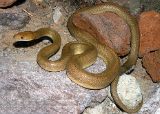Baja California Rat Snake (Bogertophis rosalia)
Description: The Baja California rat snake is a large, slender colubrid snake with a long head, large eyes, and smooth dorsal scales. Adults have a total length (including tail) of 33–59 inches. Each dorsal scale contains two apical pits. The dorsum is uniform olive or reddish brown without dark markings on a cream-colored background. Yellowish or greenish coloration extends from the lower sides of the body to the venter. The iris is yellow-green
Habitat: B. rosaliae is largely confined to mesic and dry desert habitats (rocky arroyos and washes) in the immediate vicinity of small springs but individuals have also been observed on hillsides and dry mesas away from water sources. The habitat components critical to this snake have not been identified precisely, but it may require some kind of shrub or tree with a moderately dense crown in which to take refuge because it has been taken in native fan palms (Washingtonia spp.), date palms (Phoenix dactylifera), mesquite, palo blanco (Lysiloma candidum), palo verde, and creosote bush associations in the past.
Range: The Baja California rat snake ranges from extreme southern Imperial County, California, southward into Baja California to Cabo San Lucas. Over at least the northern half of its range, it is known from widely disjunctive locations. Its known elevations range from near sea level to ca. 980 ft. In the United States, B. rosaliae is known from only one road-killed specimen, CSDSNH 644161 taken 26 May 1984 on Interstate Highway 8, 3.84 km (2 mi) east of Mountain Spring (Imperial County), California. Although Stebbins (1985) and others believe this locality to be genuine (L. Grismer and G. Pregill, pers. comm.), some have questioned the validity of this record.
Found in these States:
CA
Diet: Probably preys mostly on small mammals, but has also been found to consume bats and lizards.
Reproduction: Females are oviparous - laying eggs. Lays a clutch of 2 - 10 eggs in the spring. Eggs probably hatch from early June through late October.
Status: Listed as Least Concern in view of the fairly large and probably relatively stable extent of occurrence, area of occupancy, number of subpopulations, and population size. No major threats have been identified.
»» Kingdom: Animalia - Animals
»» Phylum: Chordata - Chordates
»» Subphylum: Vertebrata - Vertebrates
»» Class: Reptilia - Reptiles
»» Order: Squamata - Scaled Reptiles
»» Suborder: Serpentes
»» Superfamily: Colubroidea
»» Family: Colubridae - Colubrids
»» Genus: Bogertophis
»» Species: Bogertophis rosaliae - Baja California Rat Snake
»» Subspecies: None
This article uses material from the Wikipedia article "Baja California Rat Snake", which is released under the Creative Commons Attribution-Share-Alike License 3.0. Content may have been omitted from the original, but no content has been changed or extended.
|








